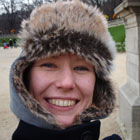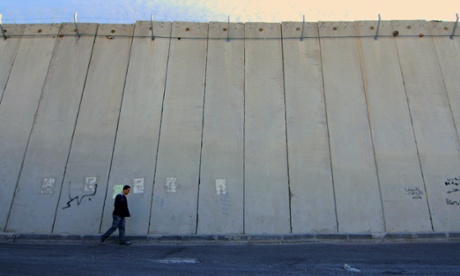There’s a surreal moment near the start of Koudelka Shooting Holy Land, a documentary about the acclaimed photographer Josef Koudelka. He has pointed his lens at one of the concrete barriers that separate Israel and Palestine but has been stopped by an official and a heavily armed soldier. His local assistant, Gilad Baram, is trying to smooth things over. “It might result in a book,” Baram tells the soldier. “He is a one of the most renowned photographers worldwide. He is a photographer with an agency called Magnum.”
Suddenly the atmosphere changes. “Magnum? Ah, I know it,” says the soldier, his stern face breaking into a smile. A short discussion later, a friendly handshake and all is well.
It is one of many quietly absurd scenes in Koudelka Shooting Holy Land, filmed on lengthy visits Koudelka took to the region between 2008 and 2012, making work that was published in the book Wall: Israeli and Palestinian Landscape. In another scene, Koudelka goes to a fake Arab city, built by the Israeli army for practice manoeuvres so realistic they even include actors pretending to sell vegetables in the “marketplace”. Later in the film, he observes a tour guide in Hebron, in West Bank, telling his group that, while they and Jewish settlers can walk freely up and down a particular street, the Palestinian residents can only go as far as “up to this door”.
“These places have so much absurdity in them,” says Baram. “Of course, they are also a reminder of a painful reality. The film had to reflect that.”
Baram was a photography student when he was assigned to help Koudelka, one of 12 international photographers invited to the region to participate in a group project, This Place. Driving Koudelka around, translating and facilitating access, Baram became fascinated by the photographer’s unique approach , and started to film him. Initially, Koudelka was very suspicious.
“Growing up in Czechoslovakia, you watch whoever is near you because they can be secret police,” he tells me. But as he and Baram spent time together, he began to trust him. “I realised this was Gilad’s country, and he was being confronted with something, learning something he was not pleased about. In the evenings he was much more down than me, because of what we had seen. And he developed this technique where he put the camera on the tripod [to film] and kept a certain distance, so he didn’t bother me. In the end, I didn’t even notice he was there.”
Initially, Koudelka didn’t want to work in Israel because he was wary of “getting mixed up” and emotionally involved – he paid for his first trip there himself so he wouldn’t feel beholden. Then Koudelka found himself deeply interested in the barrier built by Israel in the West Bank, which struck a chord because of his own experience of living behind the iron curtain.
He researched “where the money [for the project] came from” and, once he was satisfied, finally agreed to start work. But he refused suggestions of who to meet, preferring to discover the land on his own terms. “When they offered me to meet a rabbi, some historians, and others, I told them, ‘Thank you, but no. I have this experience from Czechoslovakia. First of all I want to see by myself, and get to my knowledge through my eyes.”
See it through his own eyes he does, as Baram’s film shows. Koudelka, who was in his 70s on these trips, worked long hours every day, walking along both sides of the barrier, speaking with those he encountered and taking photographs of the landscape. He returned to the same places over the years to see them at different times of the day or year, or in different weather.
Baram’s film opens with a two-minute single, static shot of Koudelka at the fortified entrance road to Rachel’s Tomb. The photographer keeps shifting slightly to get the image exactly right. “You want to see everything, as much as possible, and to find the place where you think the photograph is waiting for you, and then build from these pieces a mosaic that can make a certain statement,” he explains.
Such independence has characterised Koudelka’s long career. In 1968, he witnessed the Soviets violently suppress the Prague Spring in Czechoslovakia and took to the streets, photographing the locals but also the invading soldiers. He didn’t feel hatred towards them, he says in the documentary. “I felt that what happened to them could happen to me. One night they could wake me up, put me on the tank, and I could be somewhere, in Warsaw or in Bucharest, in their situation. So then you’re a soldier and, in most cases, a soldier does what he is told to do.”
For the past three decades, Koudelka has used a panoramic camera and photographed landscapes shaped by human activity. The scenes he depicts are usually devoid of people, but human actions have changed everything, whether it’s scarring the landscape with mines or huge concrete barriers, or building the roads, fortresses, and temples. These human interventions are an expression of power over the environment, and over each other. “Control over sources of water is one example,” he says. “You start by making roads – if you have the infrastructure, it helps you to establish your domination.”
He believes people should interpret his photographs for themselves, but his images of the barrier in the West Bank are undeniably bleak. A long-distance shot of the Shu’afat refugee camp shows a nine-foot concrete barrier snaking all the way down from one corner of Koudelka’s wide panoramic image to the other; his depiction of the entrance to Rachel’s Tomb shows the walls closing in like a prison.
“Photography is so easy,” he says. “You just press the button. But photography is so difficult. There are some photographers, a few, who have got a vision. There are many more who have got a certain style. What is vision? It is, I think, where you were born, how you grow up, what sort of parents you had, the education you got, whatever happened to you, and how finally you get to a certain point. Style you can copy very easily. Vision, not really.”
• Learn more about the documentary at koudelka-film.com. Rent it on Vimeo.










